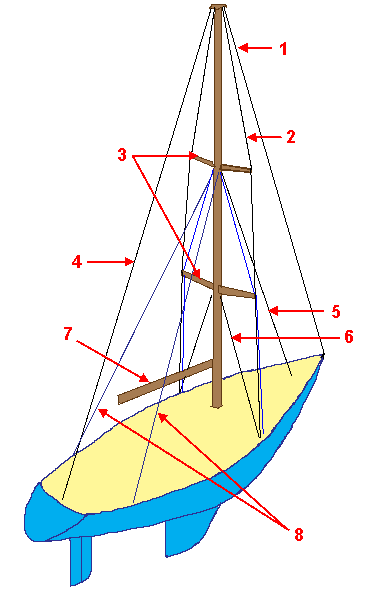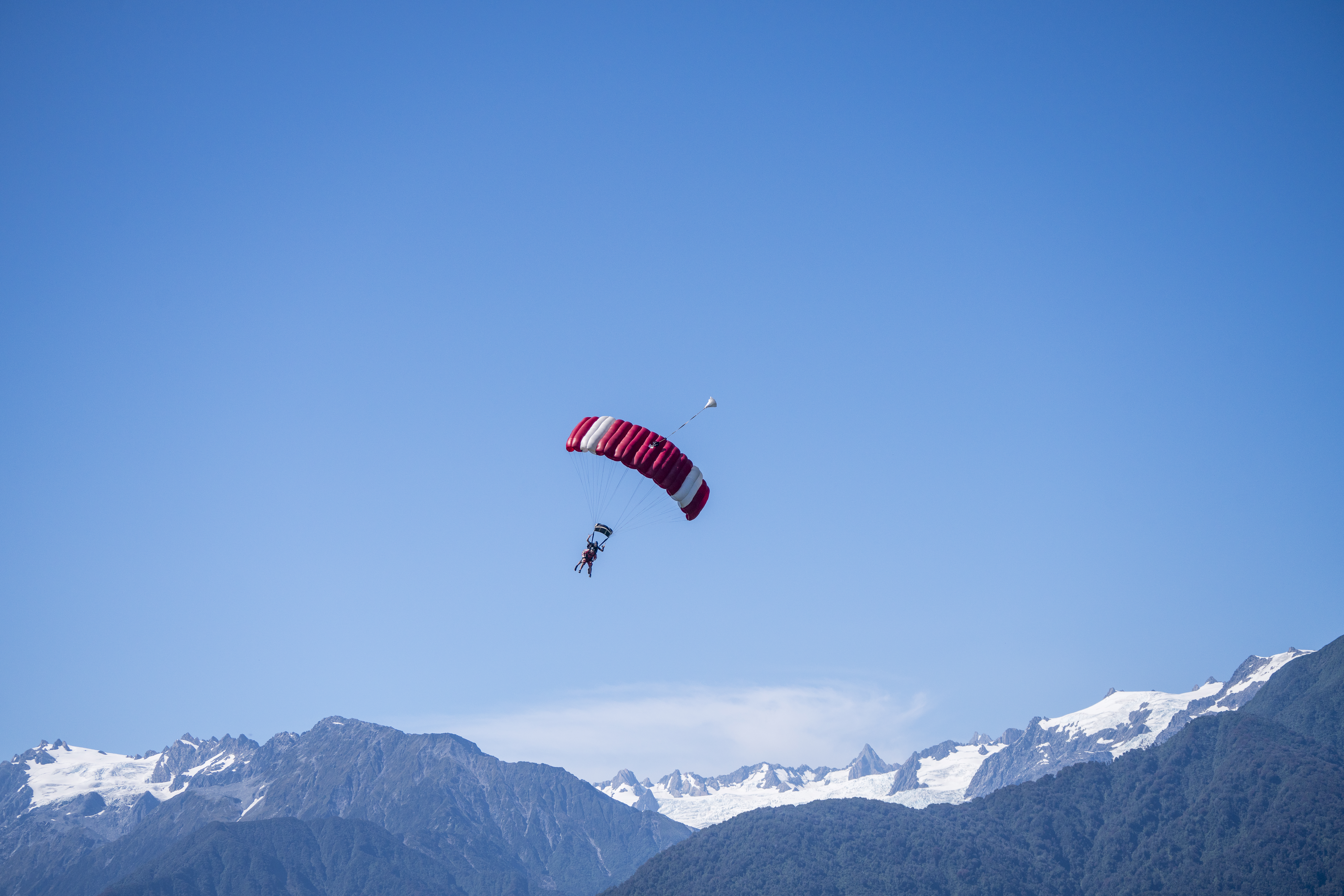|
Shroud Lines
In parachuting, the term shroud lines is an old name for suspension lines. Such lines are thin cords which attach the canopy to the risers. On sailboats, shrouds are used as standing rigging to keep a mast vertical. On biplanes and triplanes, shrouds are used as the thin wire bracing between the wing A wing is a type of fin that produces lift while moving through air or some other fluid. Accordingly, wings have streamlined cross-sections that are subject to aerodynamic forces and act as airfoils. A wing's aerodynamic efficiency is expres ...s. Parachuting Sailboats {{Air-sports-stub ... [...More Info...] [...Related Items...] OR: [Wikipedia] [Google] [Baidu] |
Parachuting
Parachuting, including also skydiving, is a method of transiting from a high point in the atmosphere to the surface of Earth with the aid of gravity, involving the control of speed during the descent using a parachute or parachutes. For human skydiving, it may involve a phase of more or less free-falling (the skydiving segment) which is a period when the parachute has not yet been deployed and the body gradually accelerates to terminal velocity. For cargo parachuting, the parachute descent may begin immediately, such as a parachute-airdrop in the lower atmosphere of Earth, or be significantly delayed, such as in a planetary atmosphere where an object is descending "under parachute" following atmospheric entry from space, and may begin only after the hypersonic entry phase and initial deceleration that occurs due to friction with the thin upper atmosphere. History Common uses Parachuting is performed as a recreational activity and a competitive sport, and is widel ... [...More Info...] [...Related Items...] OR: [Wikipedia] [Google] [Baidu] |
Canopy (parachute)
A parachute is a device used to slow the motion of an object through an atmosphere by creating drag or, in a ram-air parachute, aerodynamic lift. A major application is to support people, for recreation or as a safety device for aviators, who can exit from an aircraft at height and descend safely to earth. A parachute is usually made of a light, strong fabric. Early parachutes were made of silk. The most common fabric today is nylon. A parachute's canopy is typically dome-shaped, but some are rectangles, inverted domes, and other shapes. A variety of loads are attached to parachutes, including people, food, equipment, space capsules, and bombs. History Middle Ages In 852, in Córdoba, Spain, the Moorish man Armen Firman attempted unsuccessfully to fly by jumping from a tower while wearing a large cloak. It was recorded that "there was enough air in the folds of his cloak to prevent great injury when he reached the ground." Early Renaissance The earliest evidence f ... [...More Info...] [...Related Items...] OR: [Wikipedia] [Google] [Baidu] |
Sailboat
A sailboat or sailing boat is a boat propelled partly or entirely by sails and is smaller than a sailing ship. Distinctions in what constitutes a sailing boat and ship vary by region and maritime culture. Types Although sailboat terminology has varied across history, many terms have specific meanings in the context of modern yachting. A great number of sailboat-types may be distinguished by size, hull configuration, keel type, purpose, number and configuration of masts, and sail plan. Popular monohull designs include: Cutter The cutter is similar to a sloop with a single mast and mainsail, but generally carries the mast further aft to allow for a jib and staysail to be attached to the head stay and inner forestay, respectively. Once a common racing configuration, today it gives versatility to cruising boats, especially in allowing a small staysail to be flown from the inner stay in high winds. Catboat A catboat has a single mast mounted far forward and does not carr ... [...More Info...] [...Related Items...] OR: [Wikipedia] [Google] [Baidu] |
Standing Rigging
Standing rigging comprises the fixed lines, wires, or rods, which support each mast or bowsprit on a sailing vessel and reinforce those spars against wind loads transferred from the sails. This term is used in contrast to running rigging, which represents the moveable elements of rigging which adjust the position and shape of the sails. Historical development Early sailing vessels used rope of hemp or other fibers, which gave way to wire ropes of various types. Galvanized steel was common for the first half of the 20th century, continuing as an inexpensive option to its 1960s successor material—stainless steel cables and rods. In the late 20th Century, racing yachts adopted composite fiber lines for standing rigging, with the goal of reducing weight and windage aloft. Materials On modern yachts, standing rigging is often stainless steel wire, Nitronic-50 stainless steel rod or synthetic fiber. Semi-rigid stainless steel wire is by far the most common as it combines extre ... [...More Info...] [...Related Items...] OR: [Wikipedia] [Google] [Baidu] |
Mast (sailing)
The mast of a sailing vessel is a tall spar, or arrangement of spars, erected more or less vertically on the centre-line of a ship or boat. Its purposes include carrying sails, spars, and derricks, and giving necessary height to a navigation light, look-out position, signal yard, control position, radio aerial or signal lamp. Large ships have several masts, with the size and configuration depending on the style of ship. Nearly all sailing masts are guyed. Until the mid-19th century, all vessels' masts were made of wood formed from a single or several pieces of timber which typically consisted of the trunk of a conifer tree. From the 16th century, vessels were often built of a size requiring masts taller and thicker than could be made from single tree trunks. On these larger vessels, to achieve the required height, the masts were built from up to four sections (also called masts). From lowest to highest, these were called: lower, top, topgallant, and royal masts. Giving the ... [...More Info...] [...Related Items...] OR: [Wikipedia] [Google] [Baidu] |
Biplane
A biplane is a fixed-wing aircraft with two main wings stacked one above the other. The first powered, controlled aeroplane to fly, the Wright Flyer, used a biplane wing arrangement, as did many aircraft in the early years of aviation. While a biplane wing structure has a structural advantage over a monoplane, it produces more drag than a monoplane wing. Improved structural techniques, better materials and higher speeds made the biplane configuration obsolete for most purposes by the late 1930s. Biplanes offer several advantages over conventional cantilever monoplane designs: they permit lighter wing structures, low wing loading and smaller span for a given wing area. However, interference between the airflow over each wing increases drag substantially, and biplanes generally need extensive bracing, which causes additional drag. Biplanes are distinguished from tandem wing arrangements, where the wings are placed forward and aft, instead of above and below. The term is also ... [...More Info...] [...Related Items...] OR: [Wikipedia] [Google] [Baidu] |
Triplane
A triplane is a fixed-wing aircraft equipped with three vertically stacked wing planes. Tailplanes and canard foreplanes are not normally included in this count, although they occasionally are. Design principles The triplane arrangement may be compared with the biplane in a number of ways. A triplane arrangement has a narrower wing chord than a biplane of similar span and area. This gives each wing-plane a slender appearance with higher aspect ratio, making it more efficient and giving increased lift. This potentially offers a faster rate of climb and tighter turning radius, both of which are important in a fighter. The Sopwith Triplane was a successful example, having the same wing span as the equivalent biplane, the Sopwith Pup. Alternatively, a triplane has reduced span compared to a biplane of given wing area and aspect ratio, leading to a more compact and lightweight structure. This potentially offers better maneuverability for a fighter, and higher load-capacity wit ... [...More Info...] [...Related Items...] OR: [Wikipedia] [Google] [Baidu] |
Wing
A wing is a type of fin that produces lift while moving through air or some other fluid. Accordingly, wings have streamlined cross-sections that are subject to aerodynamic forces and act as airfoils. A wing's aerodynamic efficiency is expressed as its lift-to-drag ratio. The lift a wing generates at a given speed and angle of attack can be one to two orders of magnitude greater than the total drag on the wing. A high lift-to-drag ratio requires a significantly smaller thrust to propel the wings through the air at sufficient lift. Lifting structures used in water include various foils, such as hydrofoils. Hydrodynamics is the governing science, rather than aerodynamics. Applications of underwater foils occur in hydroplanes, sailboats and submarines. Etymology and usage For many centuries, the word "wing", from the Old Norse ''vængr'', referred mainly to the foremost limbs of birds (in addition to the architectural aisle). But in recent centuries the word's meaning has ... [...More Info...] [...Related Items...] OR: [Wikipedia] [Google] [Baidu] |
Parachuting
Parachuting, including also skydiving, is a method of transiting from a high point in the atmosphere to the surface of Earth with the aid of gravity, involving the control of speed during the descent using a parachute or parachutes. For human skydiving, it may involve a phase of more or less free-falling (the skydiving segment) which is a period when the parachute has not yet been deployed and the body gradually accelerates to terminal velocity. For cargo parachuting, the parachute descent may begin immediately, such as a parachute-airdrop in the lower atmosphere of Earth, or be significantly delayed, such as in a planetary atmosphere where an object is descending "under parachute" following atmospheric entry from space, and may begin only after the hypersonic entry phase and initial deceleration that occurs due to friction with the thin upper atmosphere. History Common uses Parachuting is performed as a recreational activity and a competitive sport, and is widel ... [...More Info...] [...Related Items...] OR: [Wikipedia] [Google] [Baidu] |




.jpg)
.jpg)
.jpg)
